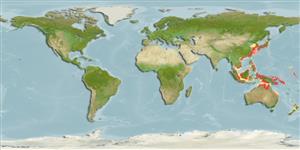Environment: milieu / climate zone / depth range / distribution range
Ekologi
laut dasar (demersal). Tropical
Northwest Pacific: southern Japan to the China seas. Possibly in Thailand (Ref. 9918). Reported from India (Ref. 45255).
Length at first maturity / Size / Weight / umur
Maturity: Lm 57.0, range 55 - 59 cm
Max length : 100.0 cm TL jantan/; (Ref. 637)
Inhabits sandy or muddy bottom in shallow waters (Ref. 11230). Feeds on benthic animals. Spines covered with skin with poisonous glands. Ovoviviparous. Used as 'kamaboko' material (Ref. 637). Caught often by demersal trawl, trammel and gillnet fisheries, and occasionally using tangle nets.Utilized for its meat, but of limited value due to its typically small size (Ref.58048).
Life cycle and mating behavior
Kematangan | Reproduksi, perkembang biakan | Pemijahan | telur-telur | Fecundity | Larva
Exhibit ovoviparity (aplacental viviparity), with embryos feeding initially on yolk, then receiving additional nourishment from the mother by indirect absorption of uterine fluid enriched with mucus, fat or protein through specialised structures (Ref. 50449). Distinct pairing with embrace (Ref. 205). Gives birth to ~3 pups; born between 20-22 cm WD (Ref.58048).
Masuda, H., K. Amaoka, C. Araga, T. Uyeno and T. Yoshino, 1984. The fishes of the Japanese Archipelago. Vol. 1. Tokai University Press, Tokyo, Japan. 437 p. (text). (Ref. 559)
Status IUCN Red List (Ref. 130435)
penggunaan manusia
informasi lanjut
AcuanBudidaya airprofil budidaya airStrainGenetikaElectrophoresesDiturunkanPenyakit-penyakitPengolahanNutrientsMass conversion
mitraGambarStamps, Coins Misc.Suara-suaraCiguateraKecepatanTipe renangArea insangOtolithsOtakPenglihatan / visi
Alat, peralatan
laporan khas
muat turun XML
Sumber internet
Estimates based on models
Preferred temperature (Ref.
123201): 17.9 - 29.1, mean 28.1 °C (based on 1500 cells).
Phylogenetic diversity index (Ref.
82804): PD
50 = 0.5000 [Uniqueness, from 0.5 = low to 2.0 = high].
Bayesian length-weight: a=0.00776 (0.00352 - 0.01710), b=3.09 (2.89 - 3.29), in cm total length, based on LWR estimates for this (Sub)family-body shape (Ref.
93245).
Trophic level (Ref.
69278): 3.8 ±0.61 se; based on food items.
Daya lenting (Ref.
120179): sangat rendah, Waktu penggandaan populasi minimum lebih dari 14 tahun (Fec assumed to be <10).
Fishing Vulnerability (Ref.
59153): High vulnerability (60 of 100).
